A
web site dedicated to Keast Burke
Beaufoy Merlin
Keast Burke's article on Beaufoy Merlin in the A.P.-R #3,
1953

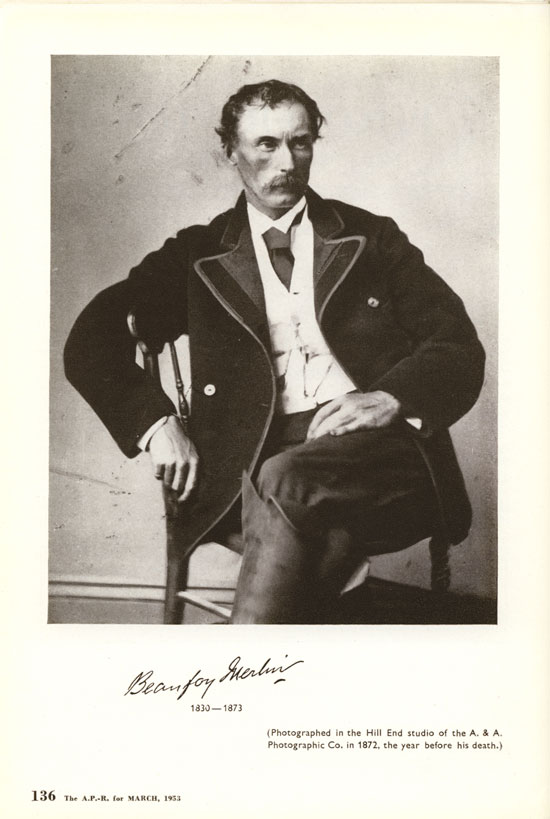
Gold and Silver
By Keast Burke
Being the story of the
association of Bernard Otto Holtermann with Beaufoy
Merlin and with Charles Bayliss
and of the
photographic collection which resulted therefrom.
"In the great days of the gold rushes, many a photographer
left behind studio and darkroom to join in the great
search - but sure Holtermann must have been the only
gold-miner who neglected his gold-mining in favour of photgraphy.
He can be ranked perhaps as Australia's first and greatest
amateur of photography, using that word in its original
French sense. He liked the art for its own sake yet
reallsed perhaps more than he knew, its great documentary potentialities.
Furthermore, he did not hesitate to spend a vast sum
upon a great series of photographs designed to convey
to the world at large the story of the colony's extraordinary
material progress. He believed that by doing so he
could, in some small measure, repay his adopted landfor the
many favours it had conjurred upon him."
JACK
CATO
The
quotation is from some unpublished mss. by Jack Cato
in connection with his forthcoming work "The
Story of the Camera, in Australia."
INTRODUCTION
On
one fateful day during the winter of 1922, two distinguished
Egyptologists stood outside a doorway in Egypt's
famed Valley of the King. For them it was an anxious
moment,
knowing that that doorway had been sealed for three
thousand five hundred years. Would this be just another
disappointment?-with nothing disclosed but a few
discarded trifles left behind'in haste by some early
tomb-robber?
The
two were not to know that soon they would be gazing
in awe and in rapture upon a storehouse
of
ancient cultural
treasures the like of which the world had never before
seen.
Some
thirty years later two Sydneysiders were destined to
stand outside a small suburban backyard
shed;
it had been locked for more than a generation,
its contents
almost forgotten, its key long since lost. Their
anticipatory feelings were hardly on the same plane
as their predecessors
but at any rate there was to be no doubt as to
the eventual
value of their discovery-the dramatic revelation
of a life and culture almost as forgotten as Tutankhamen's.
Here,
neatly stored in fitted cedar boxes were incredible
numbers of negatives, records that were
in due course
to disclose every detail of the lives of our
gold-fields pioneers-the men, the women and the children,
their
homes, their business enterprises, and their
mining shafts,
the populous towns and larger cities.
* * * * * * * * * * *
Of
all the arts of mankind, that of the photographer
is inevitably
both the most lasting and the most
perishable. Marble and canvas possess some
degree of physical strength
but the cameraman must entrust his treasures
to perishable paper and film or fragile glass.
An
oil painting
is likely to be treasured as an heirloom
or possible "Old
Master," but only too often are old photographs "just
old photographs" to someone charged with "tidying-up." Occasionally
Fate intervenes, as she is also so apt to
do in the lives of mortals, but seldom has
she been
so watchful as in
the present instance; those who have followed
this story since its inception still have
some little difficulty
in believing that it is all true, that this
marvellous thing can possibly have happened-and
the reader
may well share that view. It is a long story
and one dependent
on many, many fortunate coincidences-each
one more astonishing than the preceding.
But of all
these happenings we recognise
as the most important the part played by
photographer Beaufoy Merlin.
Chapter
One Beaufoy Merlin
Of
Beaufoy Merlin we wish we could tell more than we can.
After
eighty years the written records have become
scanty. We have his portrait, made perhaps a year
before his death; it shows a sensitive, artistic nature,
yet
one not lacking in purpose and driving force. Above
all, we have his life's work - or, at any rate, a
substantial portion of it. The images carried on those
thousands
of carte-de-visite wet plate negatives show that
he was a born photographer, one who combined an excellent
technique with a documentary outlook that is astonishingly "modern" by
to-day's view. One thing is certain, and that is
Merlin's photography was not just a matter of "bread-and-butter";
he was a born artist and one who always gave of his
best.
Henry
Beaufoy Merlin was born in 1830, the son of an English
chemist by name Frederick Merlin - the
Beaufoy
being perhaps his mother's maiden name; by the time
he arrived in Australia he was nineteen years of
age. Of
his young manhood we know little, but it can be suggested
that his interest in photography arose from the family
association with chemical science, for in those days
almost every chemist dabbled in photography. That
interest may also have been reinforced from another
quarter.
There
is a strong family tradition of association with Ballarat,
and it is certainly a fact that there were
Merlin families living in that city as far back as
the mid-fifties. The Post Office Directory for 1868
shows
an entry for T. Merlin, Photographer. It may well be
that these folk were relatives and that they afforded
hospitality to
young Beaufoy when he first landed.
He
appears to have established himself as a field
operator under the trade-name of the American & Australasian
Photographic Company and to have travelled
throughout Victoria. On these trips he made numerous
records
of the scenery, but his specialty seems to
have been house-by-house
photography. The scheme was to give a few day's
notice to the householders of the area so that
they could
array themselves, ready for the camera, in
their 'Sunday-best.'
In
1863, then being thirty-three years of
age, he married Louisa Elliott Foster and
there were
four
children of
the marriage, all of whom appear to have
had interesting and adventurous careers-but that
is another story.
Our
first documentary information regarding Merlin comes
from a Vice-Regal letter still in the possession
of family descendants. As was the custom of the photographers
of those days, he had presented the Governor of Victoria,
Sir John Henry Manners-Sutton, with an album of photographs,
and it is clear that this letter of acknowledgment is
no perfunctory routine, but one of real appreciation.
The date is October, 1869, and it shows Merlin to have
been well established as a travelling photographer; of
value to us is the fact that it refers to Merlin's plans
for the extension of his sphere of activities to other
parts of Australia.
Government
Offices, Melbourne. 7th April, 1869.
Dear
Sir,
I am directed to convey to you the thanks of His Excellency the Governor
for the very handsome book of Photographs which you have presented to
him, and which he especially values as containing so many interesting
views of the places which he visited in his tour through the Western
District last year. The
Governor desires me to request that you will
let me know the name of your agent in Melbourne
through whom His Excellency may be able to
procure copies of the views which you propose
to take in other parts of Australia.
Faithfully
yours, (Sgd.) J. S. ROTHWELL, A.D.C.
Whilst
exact dates remain uncertain, everything appears to
have moved along as Merlin had planned. Some time in
1870, with the Victorian interests of "A. & A." in
the hands of a very young but capable assistant, and
one whom he had personally trained, Merlin set forth
for that wider field which he had so long envisaged.
We pause to wonder whether he could have had any anticipation
of just what lay in store for him-a bare three years
of life-span, but three years of crowded activity and
of positive achievement. He could have had little inkling
that his work in New South Wales would establish him
as perhaps one of the greatest documentary photographers
of all time.
The
Sydney directories of 1871-1872 provide us with some
information, listing the American & Australasian
Photographic Company as being in business at 324 George
Street, at 377 Riley St., and also at 11 Barrack St.
Apart from that there is internal evidence to show
that during portions of 1870-1871 he was carrying on
with his outdoor photography in Sydney. Of special
interest is the picture of the General Post Office,
showing the building just completed, the scaffolding
having been removed - this would be in 1870. Other
photographs depict familiar harbour scenes, some of
them most pleasantly 'pictorial' in their treatment,
while others show the arrival and docking of sailing
vessels.
But
even as Merlin was setting up his 10" x 12" wet-plate
camera along the quiet foreshores and on harbour vantage
points, the tenor of life was destined to be disturbed.
The cry was once again Gold! Exactly twenty years after
those first eager rushes to the Ophir and the Turon,
the tempo was again quickening all through the area.
And then there was the new field at Gulgong, appearing
even more promising.
The
principal gold-bearing areas of the day in N.S.W.
lay approximately within (or around) the triangle
Bathurst-Orange-Mudgee, the first-named place being
about one hundred and fifty miles west of Sydney.
Though he must have had many predecessors, the credit
for the first discovery of gold goes to Edward Hammond
Hargraves, who found payable gold in a creck (which
locality he subsequently named Ophir) about nine
miles from Orange. The Turon area is to the north
of Bathurst, the principal centres being Sofala,
Hill End and Tambaroora. Gulgong lies further north,
some sixteen miles beyond Mudgee.
Photographers,
like everyone else, must live, and it is not surprising
to learn that Merlin's caravan was soon carrying his
cameras and equipment along that well-worn road that
runs westward across the Blue Mountains. Let us pause
a moment as we travel this same route at fifty miles
an hour by car or air-conditioned express, to think
back to the days of horse travel. Beyond the rail-heads,
of course, an efficient service was offered by famous
coaching companies; by changing horses every ten or
fourteen miles, some fifty or sixty miles a day could
be covered according to the terrain. For the private
traveller and the teamster it was a quite different
proposition.
Normally
he had but the one set of animals and these had to
be properly cared for at intervals
during the day and at nightfall; he was, therefore,
fortunate if he was able to maintain an average of
twenty miles a day or thereabouts. There was a substantial
degree of expense involved too. As today, those who
provided food and drink and accommodation for man
and beast had to be reimbursed. Special services might
be required as well-harness to be repaired, swingle
trees to be replaced and horseshoes to be re-nailed.
Merlin's
first picture-making stop appears to have been at
Hartley on the Cox River, across the mountains.
Of that Hartley series just two are reproduced, but
those two are more than sufficient for the realisation
of his outstanding photographic ability. Everything
was grist that came to Merlin's mill; every scene
was a subject for him. Normally there had to be human
beings
in the field of view; then, as to-day, people were
possessed with a deep appreciation of their personal
likenesses and Merlin's posing ability was always
gentle, persuasive, artistic and confident. His sitters,
despite
the necessity for a 'hold it' of some five or ten
seconds, were always naturally grouped with little
sense of
strain. So much for the demands of business; in addition,
there were many which were obviously taken solely
for his own artistic pleasure.
And
now on to Gulgong. just why he selected this new field
instead of one
or the other of the more
obvious
three Turon towns is not quite clear; he was perhaps
deterred by the latter's comparative inaccessibility.
Coming as he did from the established cities of
Melbourne and Sydney, Gulgong must have made a great
impact
on his ever-susceptible 'documentary' outlook.
The town
was indeed a strange one and we to-day, as we study
Merlin's photographs, can share something of his
reactions. The Gulgong of 1871 was veritably
an American gold-fields
town.
"Gulgong
was certainly a rough place when I visited it, but
not quite so rough as I had expected. There
was an hotel there, at which I got a bedroo-
to myself, though but a small one, and made only
ofslabs. But
a gorgeously grand edifice was being built
over our heads at the time, the old inn being still
kept
on
while the new inn was being built on the same
site. The inhabited part of the town consisted of
two streets
at right angles to each other, in each of which
every habitation and shop had probably required but
a few
days for its erection. The fronts of the shops
were covered with large advertisements - the names
and praises
of the traders - as is customary now with all
newfitngled marts: but the place looked more like a
fair
than a town - perhaps like one of those fairs which
used to
be temporary towns and to be continued for
weeks - such as some of us have seen at Amsterdam and
at Leipsic.
But with this difference-that in the cities
named the old houses are seen at the back of the new
booths,
whereas at a gold rush there is nothing behind.
Everything
needful, however, seemed to be at hand. There
were bakers, butchers, grocers and dealers in soft
goods.
There were public - houses and
banks in abundance. There was an
auctioneer's
establisLment, at which
I attended
the sale of horses and carts."
(Australia
and New Zealand, by Anthony Trollope.
Chapman & Hall,
London, 1873.)
Those
were the days when the miners and those who catered
for their economic needs followed the gold strikes
around the world; as the Australian fields came into
the news at the very time when the Californian fields
were slackening, the direction in which world interest
turned is obvious. Clearly there was many a skilful
carpenter aboard those Pacific ships and soon those
tradesmen were busily at work.
For
the main part they would care to work the wet-plate process in the field the
year round, through burning summers and piercing
winters. Merlin possessed, of course, that necessary
asset,
a wet-plate coating caravan; in fact, at one stage
he appears to have had at least two (perhaps three).
One was constructed on a light buggy "chassis," while
the other was a two-horse vehicle of more substantial
build. Both had permanent false roofs which permitted
a current of air to pass between the roof and the
coating chamber-a most desirable precaution. And,
of course,
Merlin was not working single-handed in his enterprise.
He had a driver for the caravan - we see him in many
of the photographs, standing by with a spare dark
slide
in his hands. Later on, he had at least two assistants;
their services would be needed for studio operating,
plate-coating and for floating and printing the large
sheets of albumen paper.
Merlin's
sphere of activities also covered the smaller satellite
villages that
had grown up at the various
mining fields around Gulgong. Where for generations
cattle had grazed peacefully, there was now a population
larger perhaps than that of the Adelaide of its
day, and it dwelt in what we to-day would call "shanty
towns"-but let us not be'deceived-those people
lived in homes of bark because no other building
materials were available. Most of these settlements
took their
names from the rich alluvial leads near which they
grew up. Such were Black Lead just northeast of
the town, and Home Rule and Canadian Lead about
six miles
to the south-east. And there were many others.
All of these were visited in due course and photographs
obtained of dwellings, hotels and business premises
of every description.
Nor
did he fail to visit the diamond fields on
the Cudgegong River (five miles to the west of
Gulgong)
and first-rate, even by today's standards, were
the pictures he brought back from there. He photographed
by the hundreds mining shafts and their miners,
hopeful
or successful as the case might be; and the results
appeared to sell very well. That we know for
certain for the precise Merlin has left us his sales
records,
these being carefully marked on a slip of paper
glued to each and every negative. Of the mining
subjects,
perhaps the most valuable for its record value
and news interest is one of the two which we
have reproduced,
for it shows the happenings regularly associated
with a new "strike." Other photographs
show, in actual operation, a variety of types
of almost forgotten
mining equipment as, for instance, the various
devices for ventilating-a definite necessity,
for many of these
shafts descended hundreds of feet into the earth.
"Of
course, having come to Gulgong, I had to see the
mines, and I went down the shaft of one, 150 feet deep,
with my foot in the noose of a rope. Having
offered to descend, I did not like to go back from
my word
when the moment came; but as the light of
the
day faded from my descending eyes, and as I remembered
that I
was being lowered by the operations of a
horse who might take it into his brutish head to lower
me
at
any rate he pleased - or not to lower me
at all, but to keep me suspended in that dark abyss-I
own that
my heart gave way, and that wished I had
been
less courageous. But I went down, and I came up again
- and I found six or seven men work! It the bottom
of the
hole. I afterwards saw the alluvial dirt
brought up from some other hole, puddled and ing hed
and the
gold
extracted. When extracted it was carried
away in a tin pannikin-which I thought was detracted
much from the splendour of the result.
"Of
the men around me some were miners working for
wages, and some were shareholders, each probably
with a
large stake in the concern. I could
not in the least tell
which was which. They were all dressed alike, and there in
was nothing of the master and the man in the tone
of their
conversation.
Among those present at the washing up, there were two Italians,
an American, a German, and a Scotchman, who I learned
were partners in the property. The important task
of conducting the last wash, of throwing away for
ever
the stones and dirt from which the gold had sunk,
was on this occasion confided to the hands of the
American.
The gold was carried away in a parmikin by the
German."
(Australia
and New Zealand, by Anthony Trollope-Chapman & Hall,
London, 1873.)
Towards
the end of the year a most novel assignment came his
way. He had always been recognised
as one of Australia's leading outdoor photographers (in
those days there were not very many of them), and, in
consequence, when the New South Wales Government of the
day required a photographer for The Victorian-New South
Wales Eclipse Expedition of 1871, it did not hesitate
to select Merlin for the job. This was the total eclipse
of the sun of December 12th, the occasion being Australia's
first great effort in that branch of scientific enterprise.
The
site chosen for the observation was Cape Sidmouth,
in Northern Queensland - half - way between Cape York
and Cape Flattery. It was midsummer and the temperatures
were unexpectedly high. It was 140 degrees in the dark
tent; at noon the sun was vertically overhead and no
shade could be found for the tent, while on every side
there was glare from the dazzling coral strand. No
wonder
that, on many occasions, Merlin's plates dried out
before he could get them into their processing solutions.
As
for the eclipse, rain clouds obscured it for the whole
of its totality excepting a tantalising second or two.
However, Merlin brought back some interesting locality
pictures, including one of the Queensland coast that
he obtained from the expedition steamer; the latter
was satisfactory enough to lead Merlin to place before
the
Victorian Government some eminently practical (bilt
long ahead of their time) suggestions for the use of
photography
in coastal survey work.
The early autumn saw him back in Gulgong. The evenings were drawing in and business may well have been becoming slack, with new subjects for photography to be found only in the more distant south-eastern leads. And then, one afternoon perhaps, Merlin was approached by a wellattired stranger, his waistcoat adorned by a heavy gold chain carrying two miniatures or lucky charms; this person he had never before observed in the streets of Gulgong. The visitor was a shortish, rather sad-looking individual with a sparse beard, yet very much a man of ideas and practical enterprise, and one who had survived many vicissitudes.
After a few mutual words, it appeared that the two could meet on common ground. The stranger was very much interested in photography - and he was a wealthy man; in fact, a very successful gold-miner. Merlin, on the other hand, was the practical photographer in search of new avenues for his enterprise. What better project could a wealthy miner undertake than to arrange for the effective photographic coverage of Australia's progress? What fine publicity for Australia (and for the wealthy miner) such a collection of photographs would be when exhibited in the cities of the world? No sooner discussed than it was all agreed upon.
Merlin would leave at once for Hill End and there establish a studio that would make available the regular A. & A. house-by-house and studio services. As soon as that was done he would commence work, as his patron's personal photographer, on the much broader scheme of picturing the greater cities of Australia's south-west. He would photograph, in the largest possible negative proportions, their streets, their public buildings and their industries. In this way the story of Australia's extraordinary material progress could be recorded and prepared for exhibition throughout the great centres of U.S.A. and the Continent.
Beaufoy Merlin appears to have reached Hill End in the autumn of 1872 and to have started operations immediately, but it is unlikely that he spent the whole of his time there in view of his interstate interests and the field undertaking referred to above. He probably left Hill End, for the last time, about March or April 1873, that fact being confirmed by his photography of the decorations arranged by the citizens for the visit of Sir Hercules Robinson, the State Governor, on March 11, 1873.
By the autumn of 1873 his health must have been failing rapidly and he returned to Sydney, spending his last days in one of those familiar two-storeyed terraces in Leichhardt. He passed away at the early age of forty-three of "an inflammation of the lungs," almost certainly tubercular in origin, on September 27, 1873, and was buried in the Church of England cemetery at Balmain.
And so, the Beaufoy Merlin story draws to its close. One cannot help thinking . . . if only he had known how magnificent was his work, how well preserved against the ravages of time would be his negatives and, finally, how well they would respond to modern sensitized papers and modern enlarging methods, giving 'contact quality' at 4 to 15 diameters. If only he could have seen the great travelling exhibition of his work and the interest it was destined to arouse throughout the world ....
* * * * * * * * * * *
Before we bid farewell to the old days, let us bring the background up-to-date. On the fields (and elsewhere ' ) a scattering of old men and women in their eighties and nineties are living today, most of them with keen minds, vivid recollections and a wealth of tales. The descendants of the miners are legion; in Sydney, as like as not, two out of every five at a luncheon table will tell you of their forbears of the Turon. Gulgong still stands, sharing with Mudgee the pastoral prosperity of the rich alluvial flats of the Cudgegong. Surprisingly enough, as one walks the characteristic narrow curving streets of the town, one notes on almost every hand buildings whose detail of construction bears undeniable evidence that their erection goes back to those first days when the throng of carpenters busily sawed and nailed the boards of pine into 'false fronts' of surprising variety. Quite a number of the buildings actually photographed by Merlin can be recognised without much difficulty, though, in most instances, their days are numbered. Incredibly enough, there is still one building which ante-dates to the gold-rush days by some ten years-it is the original accommodation house and posting station for the teams and other road travellers bound for the north-west.
Black Lead, just north of the railway line, remains a name on the map and many a high mullock heap is to be seen, mutely reminding us of the strenuous labours of the deep-lead miners.
At Home Rule, some six or seven miles to the south-west, digging is still in active progress, but all of it is for clay (of both the building and pottery varieties). Any of the locals will be happy to point out to you the very spot where four Irishmen found the first gold and without hesitation named their claim Home Ride.
Canadian Lead to its west is barely recognisable, for there the pits were shallow and mostly they have been filled in by the graziers.
Moving down to Tambaroora you will find it hard to reconstruct the town from a,few pine trees, a single chimney and one or two overgrown cemeteries.
Southwards across Fisher's Hill there is still a Hill End, and the wattles in their season still blaze in Golden Gully where the prospectors coming down from Hargraves met those coming up Oakey Creek from the Turon. What remains of the town dozes sleepily on its great Hawkins Hill spur high above the river. It enjoys a magnificent setting as the everchanging light plays on the slopes of the valley and on the river fifteen hundred feet below. The views are magnificent; there are many that say that the Split Rock outlook is the most beautiful in Australia. To the west, Sargent's Hill bleeds scarlet from a thousand erosion scars but the impression is softened by the rich greenery of the avenues of great shade trees planted 'by Beyers and Mayor Hodges, to say nothing of a generous sprinkling of orchard trees everywhere. Of the buildings photographed by Merlin, a handful have managed to survive the passage of time but to-day's observer is likely to be hard put to recognise some of them.
As for gold, one is more likely to encounter a boundary rider than a fossiker as one moves about the surrounding countryside. Nevertheless, a panful of gravel taken at random from any creek is likely to show a few colours in the dish. It is good fun, but undeniably strenuous; after washing half-a-dozen dishes most City dwellers would consider they had done a good day's work.
There is little local employment and it is difficult to see from whence could come any new enterprise. Hill End does not want a tourist industry and probably it is unlikely to have one. There are no golf links and there is plenty of better fishing than the Turon's. Casual walking is hardly to be encouraged by the steep slopes everywhere and the thousand unfilled, unfenced shafts would be something worse than a nightmare for parents. In any case, those fifty odd 'V.H.' miles from Bathurst will ever deter all but the most confident and well-equipped drivers.
But hope still runs strongly among those good people of Hill Endand we share those hopes . . .
(To be concluded in the May issue)
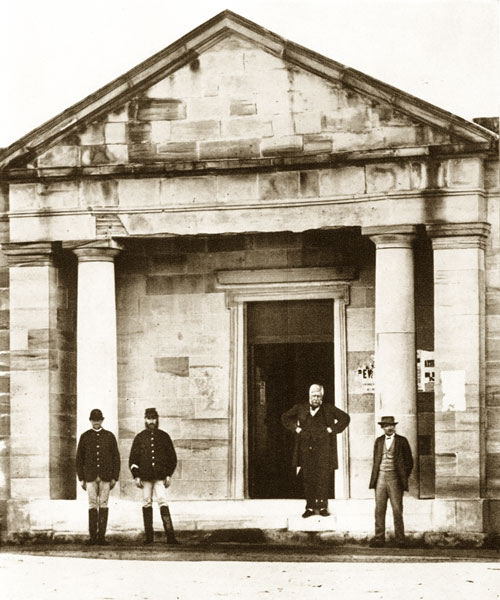
17742:
Here we see the familiar Hartley Court House as
it was
early in 1871. The central figure
appears to be
the P.M., Thomas Brown, who retired in the
same
year after sixteen years' service. The
building was erected
in 1837 and remained in active use as a court
house for half a century.
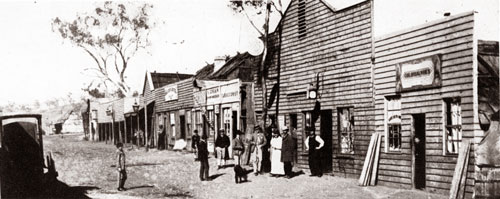
18353:
One of Gulgong's principal streets as it appeared
early in 1871. The style of building-stringy-bark
with "false-front" of
pine-was characteristic of the period.
On the extreme left we see the photographer's
wet-plate
caravan.

<
18401:
Merlin's pictures of Gulgong, Black Lead and Home
Rule are
unique in their "earliness".
We are shown Black Lead as it appeared
in its first year, the other
settlements as they stood in the first
months of their existence. Only in Australia
could the
making
of such
a record be possible.
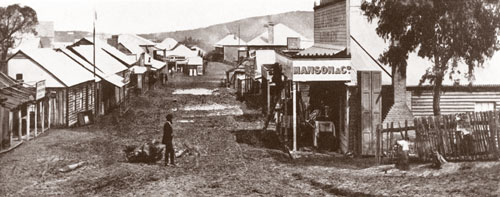
18629:
This is Clarke St., Hill End, looking south-west
from
near the present Royal Hotel, as it
appeared in the
spring of 1872, when the town was at
its
heyday. Points of interest are: Merlin's
assistant
with spare darkslide;
the signwriter at work on the signboard
outside Manson's new store; the boggy
patches in
the streets showing
the sites of old shafts; the premises
of the Australian joint Stock Bank (the two-storey
building at far end),
with Beyer's cottage just to this side
of it.
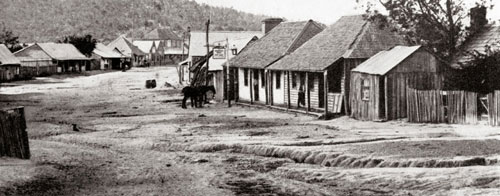
70046:
The Mudgee road passing through Tambaroora,
looking north from a -point near the
original public
school. The square brick building
at the far end is - Salkeld's
Royal Hotel; that with the twin gables
is Arthur Correy's, baker and confectioner-the
latter
is reported as having "grub
staked half the miners of the Dirt Holes".
Tombaroora (31 miles north of Hill
End) was declining in importance
by this time
(1872).
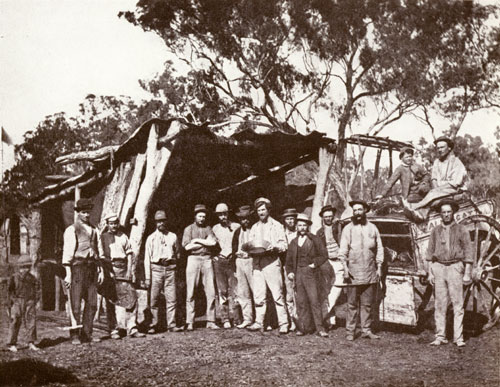
18264:
From the mining angle this is perhaps the most
interesting
of the many scores
of
similar records.
It is the
perfect documentary, showing, as
it does, all the events associated
with a gold strike. On the left
we see the red flag which the regulations
stated must
be hoisted
for
a week as soon as gold was found;
then comes the syndicate
of miners with the tallest of the
group holding the dish in which four or five
nuggets can
be seen in
the "tail";
next is the clerk from the mining
warden's office (grasping a spade
as though
he himself had found the gold);
on the right we see the butcher
included
by way of "local
colour"; as a background,
the forge (for the never-ending
tool
sharpening), and just behind
it on the right the
actual shaft and its tall whip-pole
for horse-power hoisting.

18472:
By way of contrast, this print shows a small claim
on the Gulgong field
on which
work
has just been commenced;
the reason for selection was Merlin's
fine groupings of the two sets of
figures.
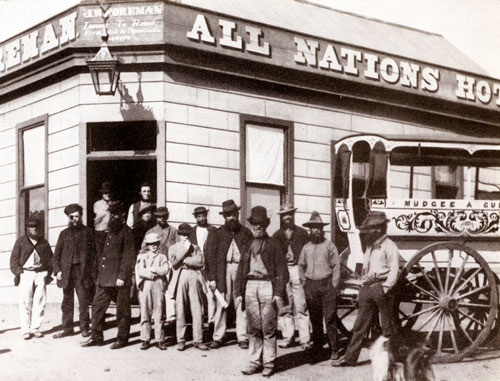
18144:
Of the numerous groups of passers-by photographed
outside hotels and
business premises, this
is perhaps the best
for its admirable depiction
of a cross section of Gulgong citizens.
Here we
are introduced
to "mine host," to
an upstanding police officer,
a miner suffering from injuries
received
from a premature blast, and,
most important of all, "Paddy".
Paddy had been a circus clown
in his younger life and was
well known
for his stage attitudes, his
incomparable flow of language
and his comical "Irishisms".
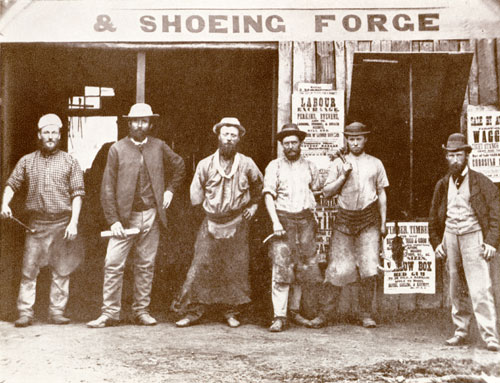
18715:
One of the best of the Hill End groups. It was
photographed
outside
Jenkyn's
shoeing forge towards
the southern
end of Clarke Street about September,
1872. The various types of workers
are represented,
while
to the right,
slightly aloof, we are introduced
to Holtermann himself. He is
to be observed
in many of
the Hill End scenes.

18793:
A feature of wet plate is its exceedingly fine-grain
structure;
in consequence,
provided the image
itself is sharp, enlargements
to a degree of ten or fifteen
times can readily be obtained.
This picture,we believe,
of the original
Hudson Bros is
a good example of the
possibilities in this direction.
The scene is of documentary interest as showing
the
complete stock of a typical
builder's
yard in 1872 galvanised
iron, staircase
uprights, and ready-made
doors, Australian ovens
and casks
of nails with everything
dumped just as it was
unloaded from the bullock
waggons.
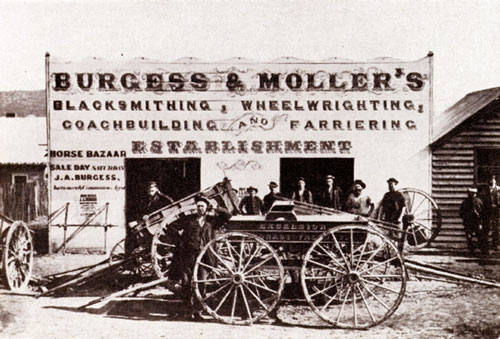
18678:
This was selected for reproduction for reasons
similar
to the
preceding one. It
is so technically
excellent
and so full of trade
interest.
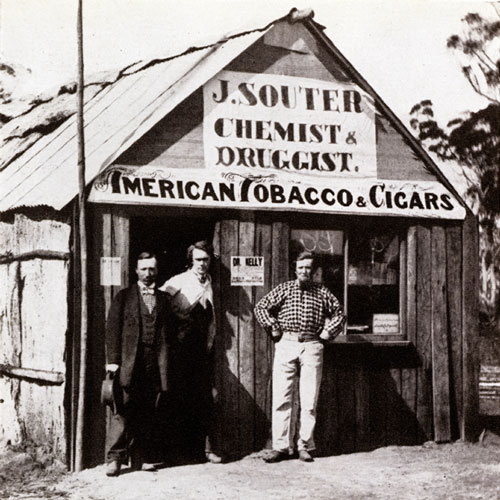
18444:
The Souters were reported the first chemists
in Gulgong, and, incidentally, their "shingle" is
still to be seen in Cleveland Street, Sydney.
They also appear to have had established the
branch in Home Rule which is here depicted. The
goldfields'
chemist shops were used as consulting rooms
by visiting doctors, and on the left we may have
the
Dr. O'Connor referred to in the left-hand notice
(as for Dr. Kelly, see below). The assistants
were not members of the Souter family.
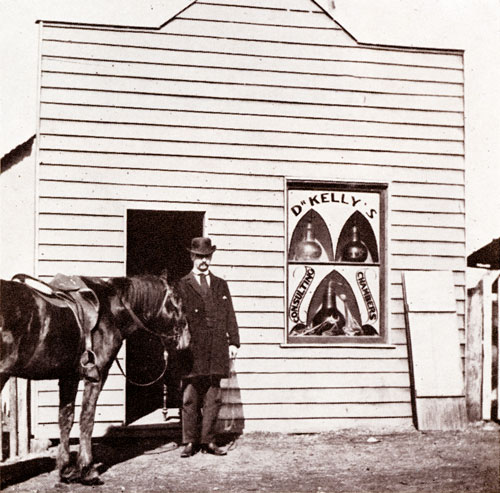
18037:
Dr. Kefly seen outside his consulting rooms
in Mayne Street, Gulgong, next door to Wood's "West
End" Stores. Of especial interest is his
window display, which comprises articulated
hands and
other bones and jars of coloured water adorned
with astrological or similar emblems.
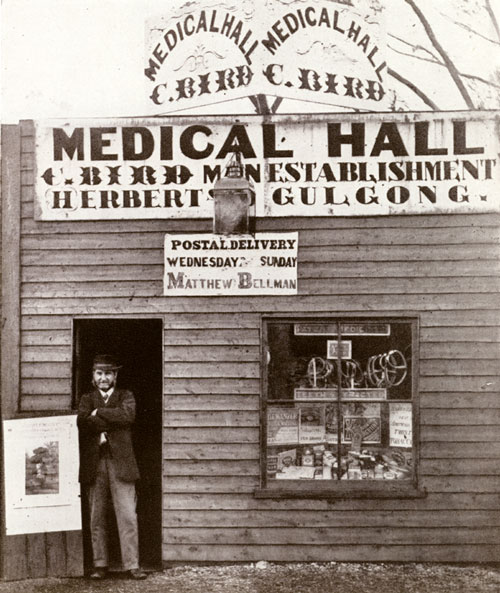
18787:
Chemist Charley Bird had two stores, one in
Gulgong and the other in Home Rule, as depicted
here
in a particularly fine technical shot. It effectively
records the contents of his display window
(trusses, cigars and sewing machines), the current
supplement
to the "Illustrated Sydney News," and
the noticeboard for the town crier, "Matthew
the Bellman". Charley, "the man with
the big ear," is recorded as one of the
town's personalities - "good company,
clever amateur actor, and a champion at all
kinds
of card
games."
18-,
18141, 18149, 18372: To select just four from scores
of pictures of commercial establishments was a
problem, but it is hoped that these four will convey
something of the "frontier" atmosphere
that was Gulgong's in the early 'seventies.
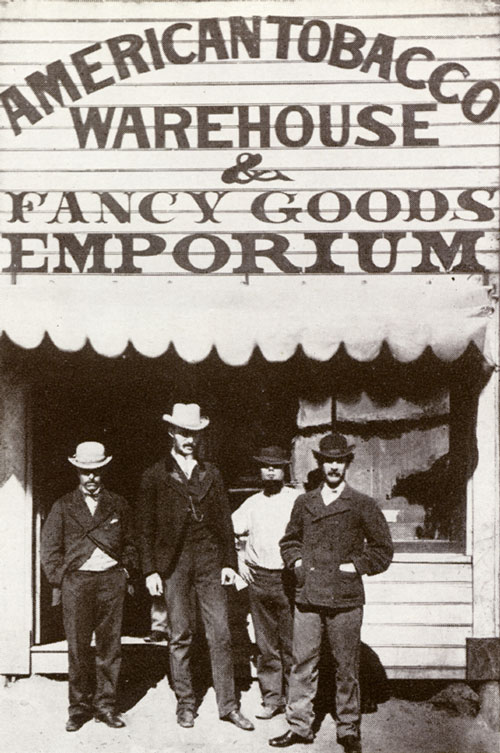
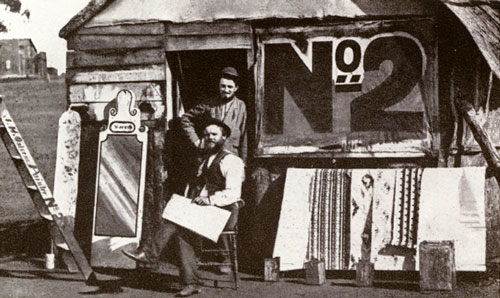

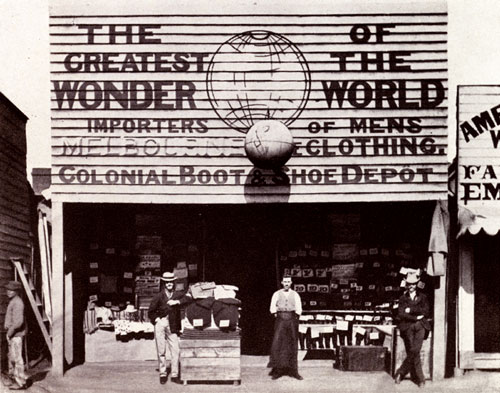
18781,
18772, 18672, 18603: Several hundreds of very informative
pictures show us the residents
of the goldfields standing outside their homes.
These four are all Hill End subjects selected
as
being somewhat more "pictorial" than
the earlier Gulgong ones, which were still in
the stringy-bark era. We are specially impressed
by
the brave showing of the pioneer women folk,
despite the incredible (to us) shortcomings in
the way
of home conveniences, to say nothing of the climatic
variations to be expected from life on an exposed
ridge three thousand feet above sea level.
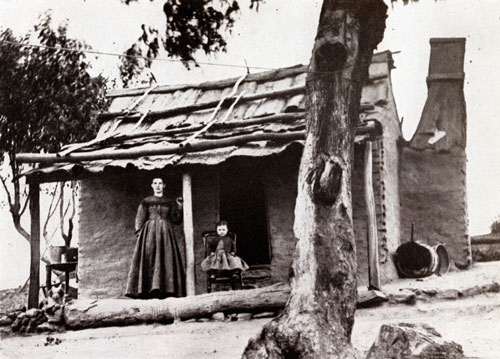
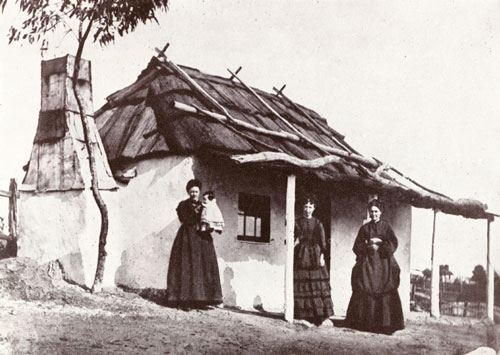

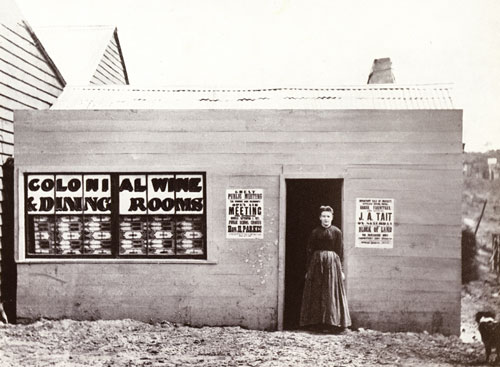
18630:
This one was selected for two reasons; first, for
the trim freshness of the premises, and, secondly,
for its obvious authenticity. The left-hand poster
refers to the visit to Hill End of the Hon. H.
Parkes and of the address which he planned for
5 p.m. on September 2nd, 1872, in the Public School
grounds.
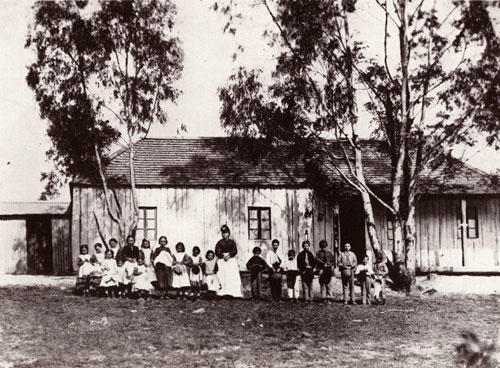
17758:
This concluding reproduction tells its own story
of Merlin's love of the great out-doors and of
his intense artistic feeling.
return to APR introduction